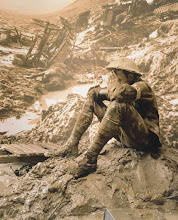
If you do not know the answer to any of these questions, then do not expect to find answers at the Syrian October War Panorama. Like a similar structure in Cairo, the panorama is a memorial disguised as a museum that purports to tell the story of the 1973 war through captured Israeli tanks and bombastic oil paintings and sculpture. The most curious part of the story is that it does not even try very hard to explain away the less than glorious bits of the fighting. That is, much attention is paid to Syria's successes in the days after launching a surprise attack on Israel. But nothing is said about the second half of the fighting, the bitter tank battles and daring counter-offensives that left the Syrians desperate for a cease-fire with Israeli guns in view of Damascus.
Having visited the Egyptian October War Panorama during my visit to Cairo this past January, I was curious to see what the Syrians would do with their own memorial museum. Both panoramas turned out to be very similar. The reason has nothing to do with the onetime allies and most times bitter rivals sharing a similar interpretation of the 1973 war. Instead it has everything to do with the fact that the same North Korean artisans designed both memorials. Apparently North Korea has some sort of monopoly on creating grandiose memorials that liberally interpret past wars. I suppose they have a lot of practice. Too bad no one ever visits North Korea to see the originals for themselves.

The panorama in Syria starts out with a line of Israeli and Syrian tanks and rockets facing each other as if the fighting just ended yesterday. All the Israel equipment, of course, is destroyed while the Syrian weapons sparkle. The best touch in the outdoor lineup is the inclusion of the Soviet shuttle that took a Syrian cosmonaut into orbit in the 1980s. As if the broken English instructions emblazoned on the outside of the space vehicle were not enough, the entire shuttle is housed within a Korean pagoda!

Inside the main hall I was treated to a ridiculously over the top documentary and three rooms that use vast oil paintings to celebrate Bashar Assad's military prowess in the 1973 war. The first room consists of four large canvases (all painted by North Koreans), each one showing another grand victory from the Syrian-Arab peoples past. After seeing past conquerors like the Umayyad caliph Al-Walid and Saladin, the paintings culminate with a heroic depiction of Hafez al-Assad directing his troops to victory in the Golan Heights.

This room is only preparation for the top floor where the entire room is painted and sculptured to create a panoramic 3-D visualization of the Battle of Kuneitra during the 1973 War. Visitors sit at the center of the room while their chair slowly spins in a circle. The military guide that led me around was quick to point out that the artwork is only a work of the imagination as the real battle in Kuneitra was nothing like what is depicted. He was less sure what message is being communicated to Syrian visitors--including the schoolchildren that visit every year--when such feats of the imagination have to be used in depicting their country's great military "victory."




No comments:
Post a Comment